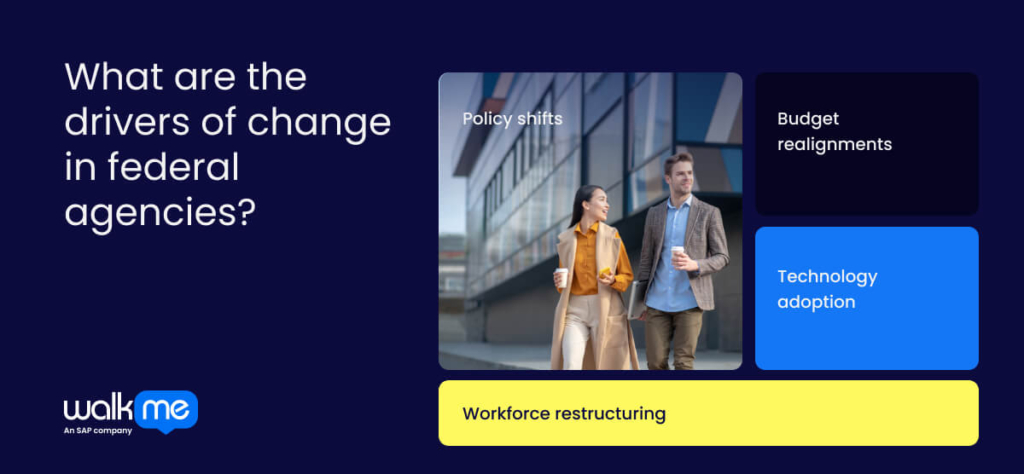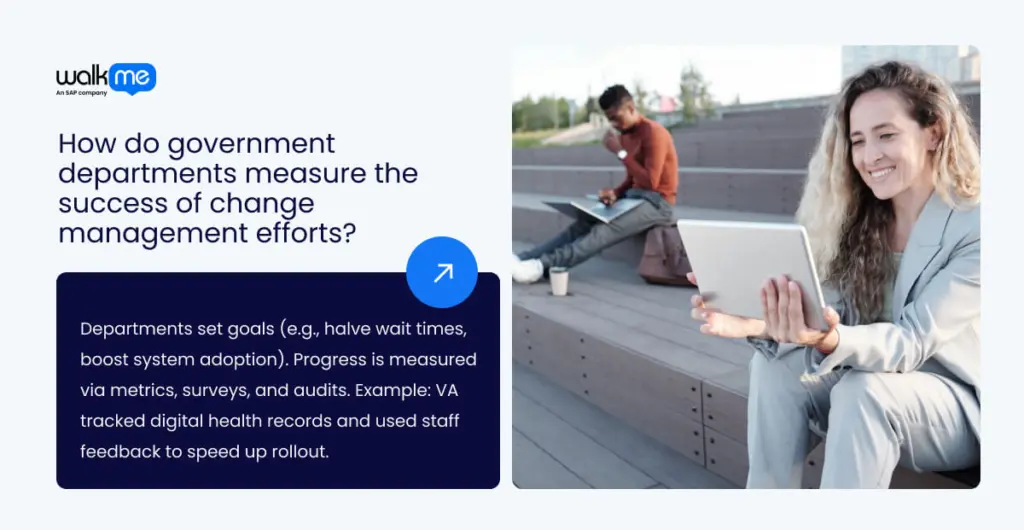Change management in U.S. government departments varies significantly across the 15 executive agencies, each of which helms unique challenges and priorities.
While some agencies focus on technological transformation, others emphasize regulatory adjustments or workforce and employee development. However, a common thread is the need for proactive communication.
Successful change management hinges on clear, consistent messaging that explains the reasons behind changes and how they will be implemented. Each department must tailor its approach to its specific mission, ensuring that employees, stakeholders, and the public understand and support the shifts.
This article will explore how federal departments handle change management through clear messaging, proactive coordination, and shared learning to meet public needs.
Why is change management essential in US government departments?
Change management is crucial for U.S. government departments because it helps them adapt to new challenges and enhance their operations.
These departments often have long-standing rules and structures, so when changes are made, there can be resistance to change. A good change management plan helps reduce confusion, gets employees on board, and makes sure the changes are successful.
For example, the Department of Health and Human Services (HHS) used Agile methods to share clinical trial data more efficiently. This change required careful planning to help employees adjust to the new way of working.
The Department of the Interior (DOI) also improved its hiring process by using new technology. Without strong change management, these efforts could have failed, making the departments less effective. In short, change management helps government departments stay flexible and meet the needs of the people they serve.
How change management works across U.S. executive departments
Change in government doesn’t move the same way across every department. Each of the 15 executive agencies operates with its own goals, pressures, and pace.
Some lead public health programs, others manage international diplomacy or defense. That means a one-size-fits-all approach doesn’t work.
With that in mind, let’s take a closer look at how change management works across the U.S. executive departments:
Department of Agriculture
In recent years, the USDA has made real progress by involving local communities in decision-making. One standout effort focused on urban farming, where residents helped shape food access programs. When federal budgets shifted, the department adjusted its strategy to keep the most important services running.
Instead of relying only on top-down planning, they listened to what people needed most and moved quickly. This kind of flexible, local-first thinking helped them keep momentum during uncertain times. It also proved that long-term change in agriculture works best when communities and government solve problems together.
Department of Commerce
The Department of Commerce used employee feedback to lead change throughout last year. Thousands of workers completed an internal survey where leaders collected the data and acted on it. They improved communication, clarified career paths, and updated internal systems.
This bottom-up approach helped boost morale and performance across several divisions. It also sent a clear message that change starts with listening. Focusing on how their teams work best, the department built a stronger foundation for supporting American businesses. It’s also a reminder that change management isn’t just about planning; it’s about people.
Department of Defense
The Department of Defense manages change through careful, proactive planning. Its 2022–2026 management plan focuses on flexibility, faster decision-making, and learning from mistakes. One example is how the military updated its training after seeing how quickly new technologies, like AI and drones, were changing army priorities.
They also added new programs for service members to learn skills that didn’t even exist a few years ago. Instead of waiting for problems to arise, the DoD builds systems that adapt in real-time. That’s what keeps them mission-ready, even in unpredictable situations.
Department of Education
Change in education doesn’t happen overnight, but it also doesn’t ensue without trust. Last year, the Department of Education tested new teaching methods in real classrooms. They worked closely with school districts, giving teachers time, tools, and support to try new ideas without burning out. Instead of forcing changes top-down, they built momentum from the ground up.
This kind of hands-on support helped students stay engaged as schools improved their teaching methods. For change to stick in education, you need patience, partnerships, and a plan that grows with the people using it.
Department of Energy
The Department of Energy is driving long-term change by altering internal habits, not just policies. Through its Federal Energy Management Program, it helps other government agencies reduce energy use by improving how buildings are operated. This includes simple shifts, such as turning off unused equipment, and more extensive efforts, like redesigning old heating systems.
The department trains employees to think about energy differently so these improvements last. Instead of one big fix, the focus is on steady change over time. This kind of thinking is what helps federal buildings use less power and reduce waste overall.
Department of Health and Human Services
The Department of Health and Human Services handles public health crises and policy shifts, so its change strategy centers on speed and coordination. When it updated telehealth regulations, it rolled out new rules and launched nationwide training for doctors, insurers, and patients.
Partnering with state agencies and health systems, HHS made sure the shift didn’t leave anyone behind. This kind of outreach-first change management matters, especially when millions rely on government health programs. It shows how planning ahead is just the beginning, and helping people understand and adapt is what drives successful change.
Department of Homeland Security
The Department of Homeland Security faces constant risk, so change happens in real time. After major cyberattacks in 2021 and 2022, the DHS created the Cyber Safety Review Board to learn quickly and address problems more quickly.
Instead of hiding failures, the department made internal reviews public, showing how mistakes helped improve national cybersecurity. This open approach turned crisis into reform. Change management here builds systems that evolve under pressure and stay transparent. For DHS, every change is also a test of trust.
Department of Housing and Urban Development
The Department of Housing and Development used change management to fix something simple but important. It decided to improve how it communicates. HUD recently redesigned its housing assistance portal after hearing from thousands of users, many of whom were navigating homelessness or eviction.
The old system was confusing, but the new one uses clear language, offers mobile access, and provides real-time updates. However, the real shift was cultural, and HUD trained its teams to treat policy change and tech upgrades as public service, not just bureaucracy. Listening closely to people’s lived experiences helped HUD reshape how it delivers support.
Department of the Interior
The Interior Department manages land, water, and wildlife, as well as history, culture, and tribal relations. It launched a program to return control of ancestral lands to Native communities. This required trust-building, education, and shared decision-making.
Leaders spent months meeting with tribal nations to co-create rules, timelines, and funding models. Instead of rushing, they moved at the pace of trust. Change here meant shifting power, not just process, which requires humility and patience, not just paperwork.
Department of Justice
Change management in the Department of Justice has historically been well structured. When revising its approach to policing reform, the department established new review units to investigate local enforcement agencies for civil rights violations.
But rather than enforce top-down rules, the DOJ partnered with cities to shape consent decrees collaboratively. They also funded training for officers on de-escalation and bias awareness. These moves built habits that prevent harm before it happens. For DOJ, change sticks when it’s embedded into day-to-day systems, not just written into law.
Department of Labor
The Department of Labor approaches change with purpose and fluidity. It recently tackled the rise of gig work by updating how employers classify workers. Rather than enforce change overnight, it launched phased guidance and feedback loops with companies and unions.
It also opened listening sessions with rideshare drivers and freelancers, ensuring policies reflected real working conditions. This approach helped avoid backlash while laying the foundation for fairer labor standards. Change here is negotiated, tested, and revised until it works for the people doing the work.
Department of State
Diplomacy changes fast, and the State Department has to work hard to keep up. After the Afghanistan withdrawal, it overhauled how it handles emergency evacuations and consular services abroad. That meant revising playbooks, investing in training, and building stronger partnerships with NGOs.
It also created a new internal feedback tool that lets diplomats share what’s working and what isn’t directly with headquarters. It’s change management shaped by those in the field, not just those in charge. For the State Department, learning from mistakes is just as critical as preventing them.
Department of Transportation
The Department of Transportation recently took on one of its biggest communication challenges. It had to learn how to prepare cities for electric vehicles. Instead of rolling out rules, it created the EV Charging Action Plan with local governments.
Each state had different needs, so the DOT built flexible funding structures and digital dashboards to track progress in real-time. Change was managed through data-sharing, collaboration, and local control. It helped give cities the authority to govern themselves autonomously and provided them with the tools to do so. That shift from direction to enablement is what made the rollout stick.
Department of the Treasury
When the Inflation Reduction Act was passed, the Treasury had to adjust how billions of dollars in climate and clean energy tax credits were handled. But instead of quietly updating forms, it made the process public, interactive, and transparent. It launched educational hubs for businesses, opened comment periods, and simplified language around incentives.
The Treasury also used pilot programs to test what worked before going national. It’s a case of change done through clarity. Removing confusion meant that money flowed to the right projects without delay.
Department of Veterans Affairs
The VA’s biggest shift in recent years has been digital. After complaints about outdated systems, it launched a full redesign of its health records platform. It paired the rollout with user training, one-on-one help for older veterans, and mental health support for those who were overwhelmed by the change.
The VA also gathered feedback from caregivers and families, not just patients. This human-centered approach turned a difficult transition into a moment of trust-building.
What are the drivers of change in federal agencies?

Change inside federal agencies doesn’t happen haphazardly and is usually sparked by something bigger. Whether internal or external, these forces shape how departments plan, hire, spend, and serve.
To keep up, agencies must respond with clear direction, steady coordination, and the ability to adapt without losing focus.
Let’s take a closer look at the drivers of change in federal agencies:
Policy shifts
New laws, executive orders, or regulatory changes often force departments to rethink priorities. Whether it’s updating education standards or changing immigration rules, policy shifts demand fast coordination. Teams must adjust digital workflows, retrain staff, and communicate clearly with the public to meet new legal responsibilities and deliver services without disruption.
Budget realignments
When funding increases or decreases, departments must pivot quickly. Programs get expanded, reduced, or shut down. This reshaping impacts staffing, timelines, and public services. Clear planning is essential to avoid waste and confusion. Leaders often make tough trade-offs while protecting their core missions and meeting congressional spending requirements.
Technology adoption
Bringing in new tech like AI, cloud tools, or cybersecurity upgrades often triggers change. Federal teams must learn new systems, update security practices, and rethink how they serve the public. Digital adoption works best when staff get support, timelines are realistic, and tools are matched to actual needs.
Workforce restructuring
Retirements, new roles, and changing skills all push agencies to reorganize. Departments might merge teams, hire differently, or retrain current staff. These shifts affect morale and leadership styles. Successful restructuring focuses on clarity, communication, and helping employees see their role in the department’s future.
Sustaining change management across government departments
Even though every federal department is part of the same government, their work is deeply varied.
A uniform approach to change sounds simple, but in practice, it rarely fits. Each department faces different pressures, timelines, and communities. Strong change management matters and creates a new structure while keeping flexibility intact.
In modern government, departments must also learn from one another, share tools, and implement organizational alignment strategies where possible.
Political leadership may change, but agency priorities, though they may shift, ultimately remain focused on serving the people. Thus, managing change well ensures they can continue to do so clearly, consistently, and with impact.

FAQs
Departments set targets, such as cutting application wait times in half or increasing the adoption rate of new systems. Progress is gauged using performance metrics, surveys, and audit results. For instance, the VA tracked how quickly health records moved to a digital platform and used staff feedback to refine training and improve deployment timelines.
Unions, like the AFGE, negotiate terms for change and bargaining over work rules, training requirements, and staffing levels. Their input shapes rollout timelines and support mechanisms. Agencies often consult union representatives before policy shifts to build consensus. Collaborative bargaining ensures that new processes respect contracts, maintain workforce morale, and safeguard the quality of public service.

